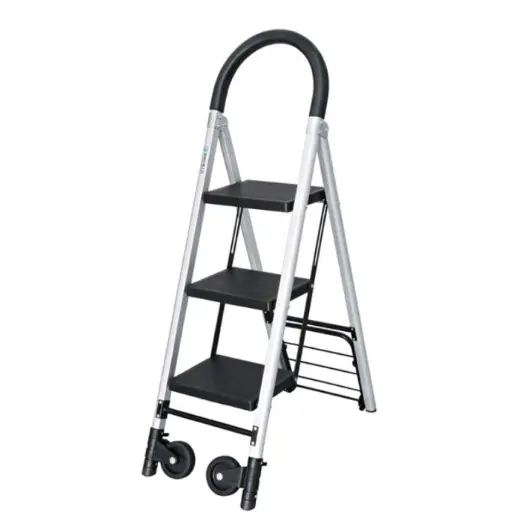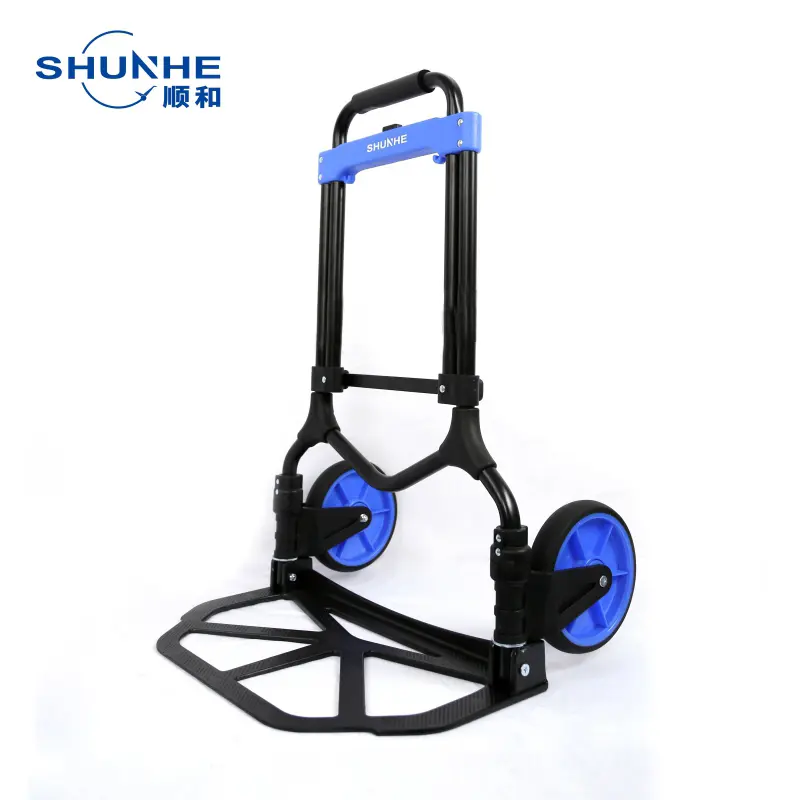Views: 220 Author: shunhehandtruck Publish Time: 2025-10-28 Origin: Site











Content Menu
● Understanding your needs and load profile
● Core construction and materials
● Wheel design and impact on efficiency
● Platform, balance, and load stability
● Handling on stairs and ramps
● Braking, safety, and operator protection
● Ergonomics and operator comfort
● Maintenance and serviceability
● Brand and supplier considerations
● Practical evaluation checklist
● Buying considerations for specific environments
● Product integration and accessories
● Environmental and sustainability considerations
● Summary guidance for selecting
● Common questions and answers
Choosing the right two wheel hand trolley can dramatically improve productivity, reduce back strain, and extend the life of your equipment. This guide helps you evaluate durability, efficiency, and overall value so you can pick a trolley that fits your daily tasks and load requirements. We'll cover key design features, material choices, load balancing, wheels and maneuverability, braking and safety, handling and ergonomics, maintenance considerations, and practical buying tips. By the end, you should feel confident selecting a two wheel hand trolley that delivers reliable performance for years to come.

Before comparing models, define your typical load, frequency of use, and terrain.
- Determine maximum weight and volume per trip.
- Consider the surface you'll roll the trolley on, such as flat concrete, carpet, gravel, or uneven pavements.
- Evaluate whether you need folding or collapsible features for storage and transport.
- Identify any special requirements, like anti-slip platforms, integrated straps, or tool compartments.
Durability stems from the choice of materials and the way they're joined.
- Frame materials: Steel frames offer high strength and impact resistance, while aluminum frames provide lighter weight and corrosion resistance. For long-term outdoor use, stainless steel may be a good compromise for corrosion resistance.
- Platform and supports: A solid platform with reinforced corners reduces denting and prolongs life under heavy loads. Look for multi-strap or recessed channels to secure goods.
- Fasteners and joints: Quality carts use heavy-duty fasteners, welded joints, or mechanical fixings designed to withstand repeated loading. Avoid carts that rely on inexpensive rivets or thin-walled tubes susceptible to fatigue.
Wheels are the most critical component for maneuverability and effort.
- Wheel size: Larger wheels roll more easily over small obstacles and provide better stability. However, very large wheels can reduce turning agility in tight spaces.
- Wheel material: Polyurethane and rubber tires with solid cores offer good grip and durability. Pneumatic tires provide superior shock absorption but require maintenance.
- Axle and bearing quality: Sealed bearings reduce dirt ingress and extend service life. Look for grease points and accessible maintenance intervals.
- Braking options: Some two wheel trolleys include handbrake or service brakes on one or both wheels, which is useful on ramps or unstable loads.
- Cornering and skid resistance: A wider wheelbase improves stability, while textured tires reduce slippage on wet or oily surfaces.
A well-balanced trolley reduces operator fatigue and prevents slipping or tipping.
- Center of gravity: A low center of gravity minimizes tipping risk, especially when negotiating ramps or stair-free transitions.
- Platform texture: Non-slip surfaces help secure loads, particularly in humid or greasy environments.
- Load containment: Straps, bungee cords, or built-in clips prevent items from shifting during movement.
- Tipping protection: Some designs include side rails or folded edges to keep loose items from sliding off the platform.
Two wheel trolleys may be used on stair-free routes; for stairs, select a model designed for stair climbing or with a foldable hand lever for lifting assistance.
- Ramp-friendly design: A gentle approach angle and stable wheelbase make rolling up gradual ramps smoother.
- Lifting aids: Some models provide a handle that can assist with lifting the load on stairs when needed, reducing wrist and back strain.
Safety features preserve both user and cargo integrity.
- Brake systems: Hand-operated brakes on one or both wheels give you control on slopes. Check for easy reach, secure locking, and smooth engagement.
- Handle ergonomics: A comfortable grip with non-slip material reduces hand fatigue during long sessions.
- Visibility: Bright color accents or reflective strips can improve safety in dim environments.
- Guarding and edge protection: Raised edges or bumper strips help prevent accidental damage to walls or goods.
Long periods of use demand ergonomic considerations.
- Handle height: Adjustable handles accommodate operators of different heights and reduce bending.
- Grip design: Contoured, cushioned grips minimize hand fatigue and prevent slipping.
- Weight distribution: A balanced trolley minimizes strain on the wrists and shoulders during push and pull maneuvers.
- Noise levels: Quiet rolling wheels reduce fatigue and improve work environment comfort.
Durability is sustained by regular maintenance and straightforward parts replacement.
- Cleaning and corrosion resistance: Choose materials with corrosion resistance, especially in humid or salty environments.
- Lubrication points: Regular greasing of bearings and moving joints extends life and smooths operation.
- Replacement parts availability: Access to wheels, bearings, straps, and platforms matters for long-term use.
- Warranty coverage: A robust warranty can offset the initial cost and reflect manufacturer confidence in durability.
Practical dimensions influence daily usability.
- Folded size: If space is limited, a compact foldable trolley is advantageous.
- Net weight: Lighter trolleys are easier to maneuver but may sacrifice load capacity or durability.
- Load area dimensions: Ensure the platform can accommodate your typical items, including packaging and containers.
- Mobility aids: Some models include additional features like a detachable handle or accessory rails.
Price should reflect performance expectations and total cost of ownership.
- Upfront cost: Compare similar configurations across brands to gauge market pricing.
- Longevity: A slightly higher upfront investment can pay off through longer service life and lower maintenance.
- Downtime risk: Carts with readily available spare parts reduce downtime and maintenance hassles.
For enterprise buyers, supplier reliability matters as much as product specs.
- Reputation: Look for brands with a track record of durable industrial equipment.
- Customer support: Accessible service channels and responsive support help with parts and repair.
- Customization: If your operation requires specific features, confirm whether the supplier can tailor the trolley to your needs.
- Compliance: Ensure products meet applicable safety standards and certifications in your region.
Use the following criteria when assessing two wheel hand trolleys in person or via spec sheets.
- Load capacity vs. actual working weight: Ensure the trolley can handle your heaviest typical load with a comfortable margin.
- Wheel robustness: Inspect tire condition, tread depth, and axle alignment. Test rolling over obstacles if possible.
- Platform integrity: Look for solid welds, reinforced corners, and absence of deformations.
- Braking reliability: Engage brakes on both wheels and verify they hold the trolley on a slope.
- Ergonomic fit: Check handle height adjustability and grip comfort.
- Maintenance accessibility: Confirm grease points and easy access to waiting parts.
Tailor your choice by considering expected daily tasks.
- Healthcare and hospitals: Quiet wheels, easy cleaning, and secure load containment for medical supplies.
- Hospitality and catering: Durable platforms, secure straps, and smooth rolling across carpeted floors and tile.
- Warehousing and logistics: Higher load capacity, robust wheels, and efficient braking for busy corridors.
- Outdoor and construction sites: Corrosion resistance, heavy-duty frames, and reliable braking on uneven surfaces.
Certain environments demand special features.
- Wet or slippery floors: Prioritize non-slip platforms and high-traction wheels.
- High-moisture settings: Stainless steel frames or coated surfaces resist corrosion.
- Tight spaces: Look for carts with versatile steering and smaller turning radii.
- Heavy-duty operations: Opt for reinforced frames, larger wheels, and stronger straps or tie-down systems.
Enhance a basic trolley's usefulness with thoughtful add-ons.
- Straps and tie-downs: Secure loads to prevent shifting.
- Baskets and tool trays: Improve organization and accessibility.
- Storage accessories: Foldable covers or protective bags can protect goods during transport.
- Mounting brackets: Add modular accessories to tailor the trolley for your workflow.
If your organization prioritizes sustainability, factor these into your choice.
- Material sourcing: Recycled steel or aluminum alloys may align with environmental goals.
- Longevity: Durable design reduces waste and replacement frequency.
- End-of-life options: Check for recycling programs or take-back schemes from manufacturers.
- Prioritize a durable frame with corrosion resistance suited to your environment.
- Choose wheels that offer the right balance of stability, traction, and maintenance needs.
- Ensure the platform and restraints keep loads secure with minimal risk of shifting.
- Favor ergonomic features that reduce operator fatigue during long shifts.
- Confirm serviceability, spare parts availability, and warranty terms.

Q1: What is the most important feature to look for in a two wheel hand trolley?
A1: The most important feature is a robust frame and wheels that match your load and terrain, ensuring reliable stability and long service life.
Q2: How do I determine the right load capacity?
A2: Compare the trolley's rated load capacity to your heaviest typical load, then add a comfortable safety margin (often 10–20%) to account for dynamic forces during movement.
Q3: Are pneumatic wheels worth it for indoor use?
A3: Pneumatic wheels offer better shock absorption on uneven surfaces but require maintenance; for smooth indoor floors, solid polyurethane wheels are usually sufficient and lower maintenance.
Q4: How can I improve trolley safety on slopes?
A4: Use braking on both wheels, secure loads with straps, and distribute weight toward the center of gravity to reduce tipping risk.
Q5: What maintenance steps extend a trolley's life?
A5: Regularly lubricate bearings and pivot points, inspect welds and fasteners, clean debris from the wheel hubs, and replace worn straps or damaged platform edges promptly.
Q6: Can I customize a standard two wheel trolley for my business?
A6: Many manufacturers offer customization options such as different handle heights, strap configurations, or additional accessories to fit specific workflows.
Q7: How do I store a two wheel hand trolley when not in use?
A7: Choose a model with a compact folded footprint and a stable standing position; store in a dry, dust-free area to prevent corrosion and wear.
Q8: What warranty should I expect for a durable trolley?
A8: A robust trolley typically carries a multi-year warranty on frame and a shorter warranty on moving parts like wheels and bearings. Check terms for coverage scope and replacement parts.
Q9: How long does it take to ship a customized trolley?
A9: Lead times vary by manufacturer and customization level; standard models may ship in days, while customized units can take several weeks.
Q10: Are there safety certifications I should verify?
A10: Yes. Look for certifications relevant to your region or industry, such as material safety, load testing, and equipment compliance standards.
Hot Tags: China, Global, OEM, private label, manufacturers, factory, suppliers, manufacturing company
Why A Two Wheel Hand Trolley Is Essential for Efficient Logistics Operations?
How To Pick The Best Two Wheel Hand Trolley for Rough Terrain And Stairs?
Choosing Between Steel And Aluminum Two Wheel Hand Trolleys: What You Need To Know?
How To Select A Durable And Efficient Two Wheel Hand Trolley?
What To Look for When Buying A Two Wheel Hand Trolley: Expert Tips?
How To Choose The Right Two Wheel Hand Trolley for Your Business?
Best Two Wheel Hand Trolleys for Moving Heavy Loads: Our Top Picks
Leading Two Wheel Hand Trolley Manufacturers in China: Quality And Innovation
Top Manufacturers of Two Wheel Hand Trolleys: Why Choose Guangdong Shunhe?
Best Two Wheel Hand Trolleys in 2025: Features, Benefits, And Buyer’s Guide